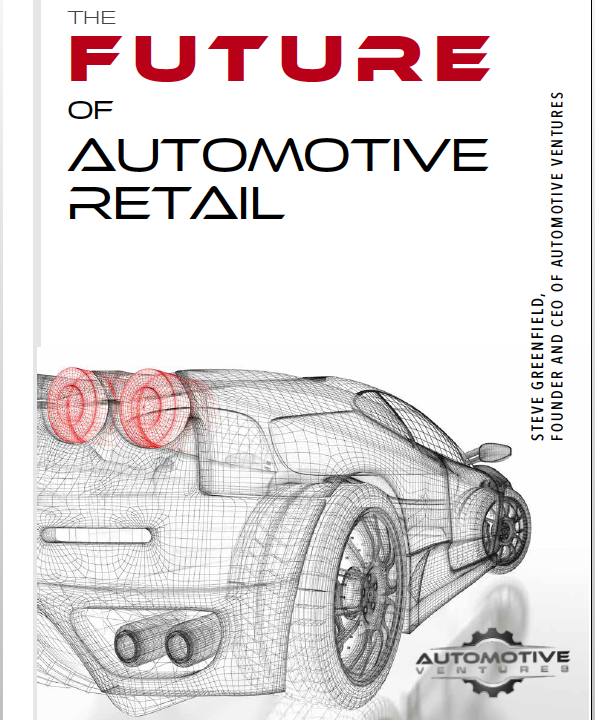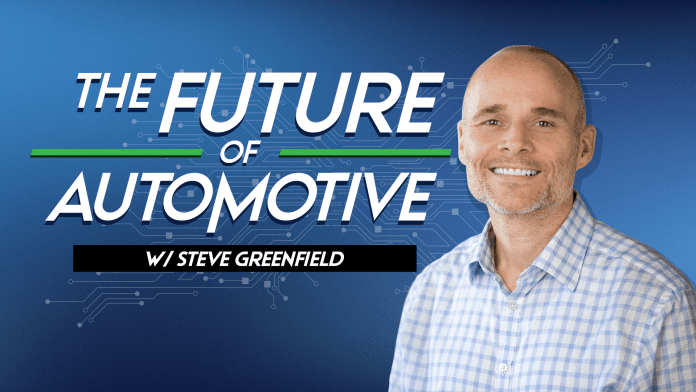Welcome to another edition of The Future of Automotive, with Steve Greenfield, Founder, and CEO of Automotive Ventures, an auto technology advisory firm that helps entrepreneurs raise money and maximize the value of their companies.
First up this week, the war for the dashboard of the vehicle continues to play out.
GM dumps Apple Carplay and Android Auto
As we’ve discussed here in the past, the automakers are growing increasingly concerned about conceding the consumer interface inside the car to either Apple or Google. But the truth is, the vast majority of consumers want to plug in their phones and mirror apps like Waze or Spotify while they’re driving.
Why are the OEMs worried about who owns the dashboard interface? They worry how disruptive Apple or Google might be to their plans to generate tens of billions of dollars in new, monthly, high-margin subscription services from drivers – for everything from increased horsepower to rear heated seats.
The latest news? GM announced plans to phase out Apple Carplay and Android Auto entirely, starting with their next generation of EVs. Instead, GM plans to build out the infotainment system themselves.
How is this going to play out for GM? That is to be determined. My gut is that GM is NOT going to be able to build a user interface anywhere near as pleasing as what Apple’s been able to accomplish.
Can you imagine a customer coming into a GM dealership and the poor salesperson having to explain to them that they can no longer sync their phone and mirror their apps? Good luck with that. In fact, I bet they lose even the most loyal of customers if they decide to stick with this strategic direction.
Poor GM HAS been receiving a lot of blowback on this decision, and hopefully, other automakers will learn from this and NOT follow suit.
EVs push parking structures to the limit
Next up are two news items that I would characterize in the area of unintended consequences or downstream effects.
First, word out of the UK that the increased weight of EVs poses a risk that older parking garages could collapse under the strain.
EVs are typically quite a bit heavier than their internal combustion counterparts due to the sheer weight of their batteries.
Many multi-story parking garages across the UK were built in the 1960s and 1970s, when cars were far lighter than today. Since then, many of these garages have suffered from neglected maintenance, leaving them susceptible to structural issues.
The concern from experts is that today’s new heavier EVs could push these tired structures beyond their limits and might increase the risk of structural overload and collapse, especially if most of the vehicles parked are heavy EV models.
China suffers from low usage of public EV chargers
Next up, continuing the theme around unintended consequences is an experiment that is playing out in China – and back here in the U.S., we should be taking notes.
China has rolled out more public charging units than the rest of the world combined. The problem? The vast majority aren’t being used.
Since it’s home to, by far the largest EV market, China is a test case for the transportation transition playing out globally. The nation installed more than 1.8 million public chargers as of last year. The rest of the world combined was at less than 1 million, with the vast majority of those in Europe.
But, public charging locations in China are used on average about once a day, with chargers along highway routes experiencing an average utilization rate of 1%.
This low usage illustrates the tricky reality of public charging networks: Reliable infrastructure is needed to help ease consumers’ anxiety about running out of battery range, but more EVs are needed to make the stations economically viable.
China’s predicament suggests that charging infrastructure investment back here in the U.S. to support higher electric-car adoption may take a long time to pay off. It’s going to be very important that we build these chargers in the right locations where consumers need them and will use them.
Electrification costs hamper transition
Next up this week, we got a bit more indication of just how much new EV initiatives might drag on legacy automakers’ profitability as they make the transition from internal combustion to electric drivetrains.
We heard recently that Ford expects its electric vehicle business unit to lose $3 billion this year.
This week, RAM noted that the cost of electrification is so expensive that they need to keep their internal combustion business healthy to help fund the transition.
If the legacy automakers are going to spend tens of billions of dollars to make the transition from ICE vehicles to EVs while at the same time investing heavily to wrestle away the software interface from Apple and Google, I think that some of the smaller OEMs just might not have the scale to be able to accomplish both simultaneously. Trying to do both might break the backs of some of the smaller automakers and force a wave of consolidation of OEMs, who will benefit from the scale efficiencies that will be needed to fund these two enormous transitions.
How generative AI will change the automotive retailing landscape
Finally this week, a topic that’s become a recurring theme on this show, is an update on the massive opportunity that Artificial Intelligence, or AI, may provide to the automotive industry.
Things are evolving so quickly with AI that recently more than 1,000 tech and AI experts signed a petition for the industry to take a six-month moratorium on the training of artificial intelligence systems more powerful than OpenAI’s GPT-4.
A handful of experiments are indicating the astonishing potential of generative AI to replace workers.
With ChatGPT, professionals such as grant writers, data analysts, and human-resource professionals were able to produce news releases, short reports, and emails in 37% less time, with superior results.
Chat GPT-4 was recently tested with a variety of standardized tests from high school to graduate to the professional level and spanning across mathematics, science, software coding, history, and literature.
GPT-4 scored in the 88th percentile on the LSAT and did even better on the legal Bar Exam: scoring in the 90th percentile.
GPT-4 took both the math and reading/writing sections of the SATs and all three sections of the GREs which are broken down into quantitative, verbal, and writing skills. It scored in the 80th or 90th percentile of all sections except for the writing section of the GREs, where it only scored in the 54th percentile.
GPT-4 also took all the Advanced Placement high school exams. It aced most of them, scoring between the 84th and 100th percentile.
These are game-changing results.
Goldman Sachs economists, generalizing to the entire economy, conclude generative AI could raise labor-productivity growth—the building block for economic growth—by almost 1.5 percentage points a year, a de facto doubling from its current rate.
I have yet to see really compelling use cases for AI in retail automotive, but it’s just a matter of time. I believe we’re about to see a wave of new startups that help dealers automate many manual tasks.
Like the way kids today would react to seeing a rotary phone, I bet the next generation of dealers will look back and be surprised that we even had BDCs to handle customers and follow up on leads.
So there you have it. You don’t have to believe me when I say that the pace of change in this industry is accelerating, and we’ll see more change in the next 10 years than we’ve seen in the past 100. But in any event, I encourage you to keep a close eye on the news cycle and stay tuned to each episode of The Future of Automotive here on CBT News.
Companies To Watch
Every week we highlight interesting companies in the automotive technology space to keep an eye on. If you read my monthly industry Intel Report, which you can subscribe to for free, I showcase a few companies each month, and we take the opportunity here on this segment to share some of those companies each week with you.
Today, we have two companies to watch: Gather Insurance and GridMatrix.
Gather Insurance
Our first company to watch this week is Gather Insurance.
Cather Insurance is the only compliant solution for in-dealership auto insurance validation.
Gather helps auto dealers stay out of vehicle insurance entirely by taking the burden of insurance off your hands.
By simply referring customers to Gather, you’ll improve their customer experience all while earning scalable revenue for your business.
The reason that I love Gather Insurance is that they pay auto dealers for every customer insurance policy it updates on their behalf. No more chasing down proof of insurance or updating policies with lienholder information. At Gather, they handle all of the messy paperwork and even reward your dealership with revenue for each customer you refer.
You can check out Gather Insurance at www.GatherInsurance.us.
GridMatrix
Our second company to watch this week is GridMatrix.
Gridmatrix’s cloud-based software platform eliminates traffic congestion, accidents, and emissions.
Using data from existing sensors as well as cloud-based sources, GridMatrix helps cities accelerate their transportation goals and ultimately transform into safer, greener, and more efficient places to live and work.
The reason that I love Gridmatrix is that advances across the autonomous, connected, electric, and shared technology areas require the development of new infrastructure within cities to support deployment and adoption. Gridmatrix is uniquely positioned to help with the digital infrastructure required and accelerate the shift to new forms of mobility.
You can check out GridMatrix at www.GridMatrix.com.


If you’re an AutoTech entrepreneur working on a solution that helps car dealerships, we want to hear from you. We are actively investing out of our new DealerFund.
If you’re a dealer who wants to invest in early-stage AutoTech companies that benefit your business, let me know. We are still accepting new investors into the DealerFund.
If you’re interested in joining our Investment Club to make direct investments into AutoTech and Mobility startups with small checks, join the Club. There is no obligation to start seeing our deal flow.
And don’t forget to check out my book, The Future of Automotive Retail, on Amazon.com.
Thank you for tuning into CBT News for this week’s Future of Automotive segment, and we’ll see you next week!



